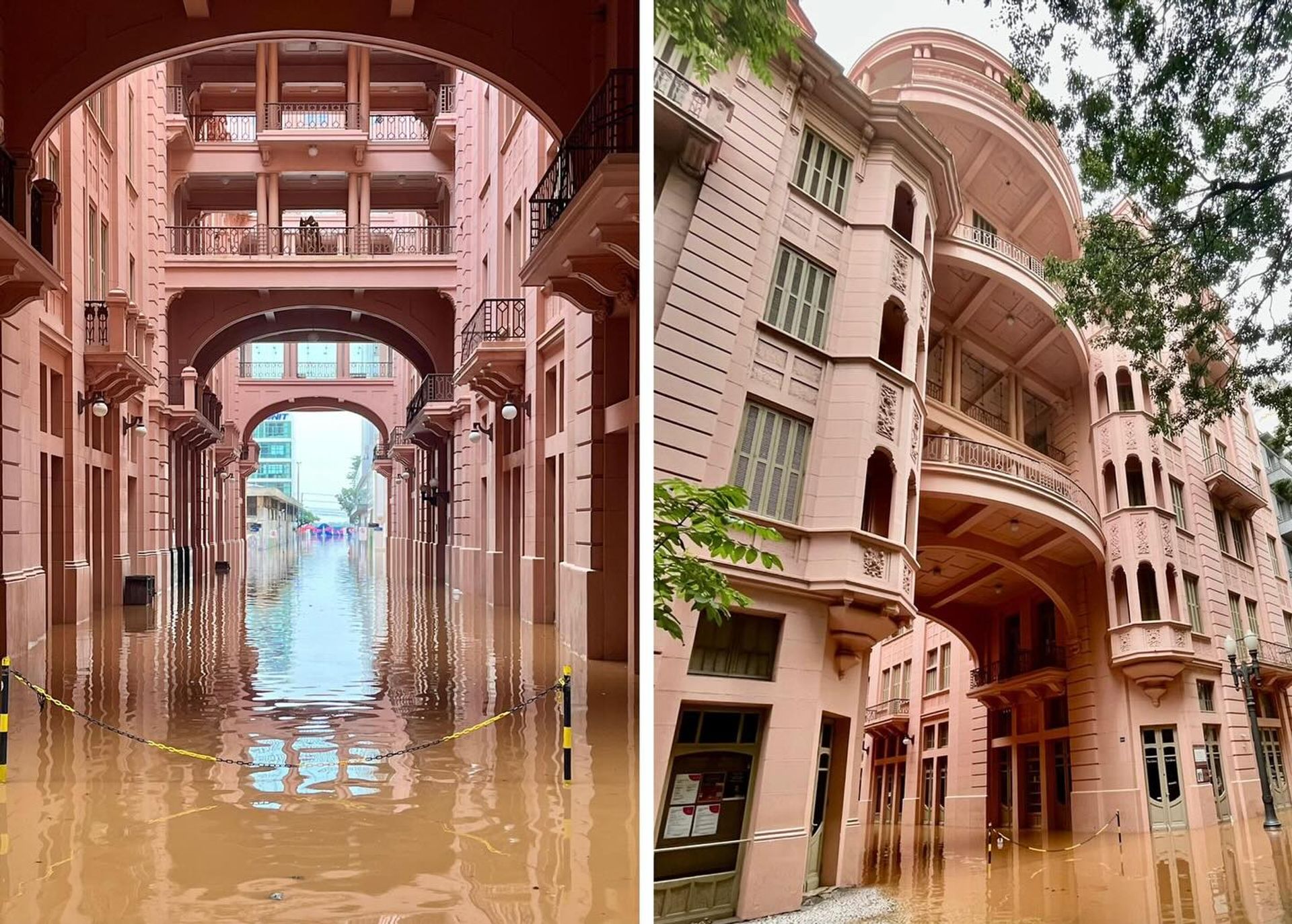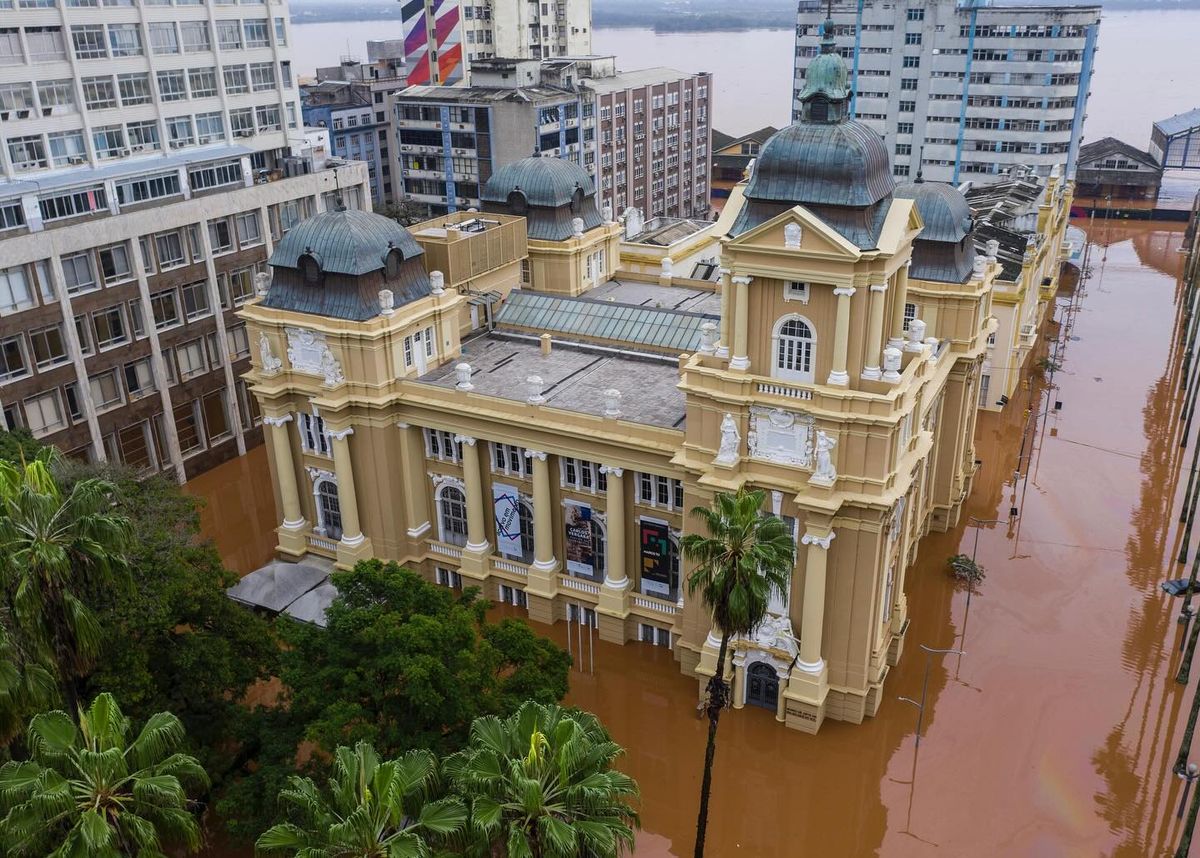Since the end of April, a series of ongoing, torrential rainstorms and floods have battered the southern Brazilian state of Rio Grande do Sul, causing severe damage to museums and heritage sites throughout the region. According to a Brazilian Ministry of Culture’s recently formed task force, launched to determine the impact of this historic rainfall, more than 50 of the 378 museums registered in the state have suffered structural damage caused by rain and flooding; nearly 100 municipalities have reported damage to archaeological sites, libraries, galleries, theatres and art and historical collections.
Almost all of Rio Grande do Sul’s municipalities—467 out of 497—have been affected, with some almost completely submerged. Nearly 650,000 people have lost their homes, and there have been over 165 recorded deaths, including from a recent outbreak of the waterborne disease leptospirosis. More than 60 people remain missing.
This month, the Brazilian government released a federal aid package equivalent to almost $10bn for the state. There has been around $3.7bn in damage, and an estimated 90% of businesses in Rio Grande do Sul have reported partial or total losses. A budget for cultural projects has not been announced, but disruptions to the cultural calendar are expected for the foreseeable future.
Last week, the Mercosul Biennial in the state capital of Porto Alegre, one of the largest biennials in South America, postponed its 14th edition, which was slated to open in September across various spaces that have already suspended operations indefinitely. “The biennial will take place at the right time to revive the artistic sector and attract visitors back to the capital,” its organisers said in a statement.
Porto Alegre’s Casa de Cultura Mario Quintana (CCMQ), an arts centre consisting of several museums and commercial spaces, began the inspection of its buildings last week, when the waters receded and it was possible to enter its grounds on foot. CCMQ is still assessing the damage but confirms that the interior and exterior of the main building will need to be repainted and its wooden frames and doors, water tanks and furniture that could not be removed in time will need to be replaced.
Commercial spaces on the ground floor of CCMQ’s buildings have been particularly affected. The bookstore Livraria Taverna’s books were first moved to upper floors but have since been placed in separate facilities to limit exposure to humidity and rising waters. And there is still no electricity to verify damage to electrical equipment in the three cinemas that make up the Cinemateca Paulo Amorim, which was submerged under half a metre of water. Inspectors confirmed that all of its carpets, air-conditioning units and 260 seats will need to be replaced; mud and humidity in the theatre have prevented inspectors from determining the full extent of the damage.

Flooding at Casa de Cultura Mario Quintana (CCMQ) in Porto Alegre, Brazil Image: Secretaria da Cultura do RS via Facebook
CCMQ will reopen and resume its public programming “as soon as possible to maintain the work of numerous artists, technicians and cultural agents who keep the creative chain alive and who depend on it for their livelihood”, Germana Konrath, the director of the centre, tells The Art Newspaper. “We have always been an important open space for meetings and exchanges, and this becomes even more relevant at this time.”
The CCMQ’s collection, which includes historical archives—like those related to the Brazilian poets Mário Quintana and Elis Regina—is housed on the second floor and did not suffer flood-related damage. Luckily, several other museum collections in Porto Alegre, like the Museu de Arte Contemporânea do Rio Grande do Sul (located on upper floors in CCMQ) and the Museu de Arte do Rio Grande do Sul Ado Malagoli, also remain unscathed. They had taken preventive measures as meteorological alerts started on 22 April.
Elsewhere in the city, the museum Fundação Iberê Camargo confirms that its basement was emptied of works of art before the floods. Likewise at the cultural centre Farol Santander Porto Alegre, which only suffered damage to its ground-level restaurant and gift shop. Exhibitions have been closed indefinitely, and all events scheduled through June have been postponed.
Grave damage was suffered by some smaller museums in the state—like the Museu Histórico Visconde de São Leopoldo, which explores German immigration to the state. There, water submerged documents, photographs, books and other objects, including a 120-year-old Schiedmayer piano, which has been irreparably damaged. The Sistema Estadual de Museus do Rio Grande do Sul, which administers the state’s museums, expects that it will receive contributions to support those most affected by the floods. Several museums have also launched their own calls for donations.
During a public seminar last week ahead of November’s G20 Summit in Rio de Janeiro, representatives from Unesco, as well as from Brazil’s National Historical and Artistic Heritage Institute and the International Council on Monuments and Sites, discussed risk-management techniques for cultural heritage. Addressing the climate tragedy in Rio Grande do Sul, Marlova Jovchelovitch Noleto, Unesco’s representative in Brazil, said: “We must emphasise that human actions and social inequalities lead to the catastrophic events we are experiencing now.”
Southern Brazil has experienced a 30% increase in average rainfall in the past three decades, according to a recent climate report. The report also found a lack of public policies in Brazil to mitigate the effects of climate change—a new overarching focus of the administration of president Luiz Inácio Lula da Silva.


